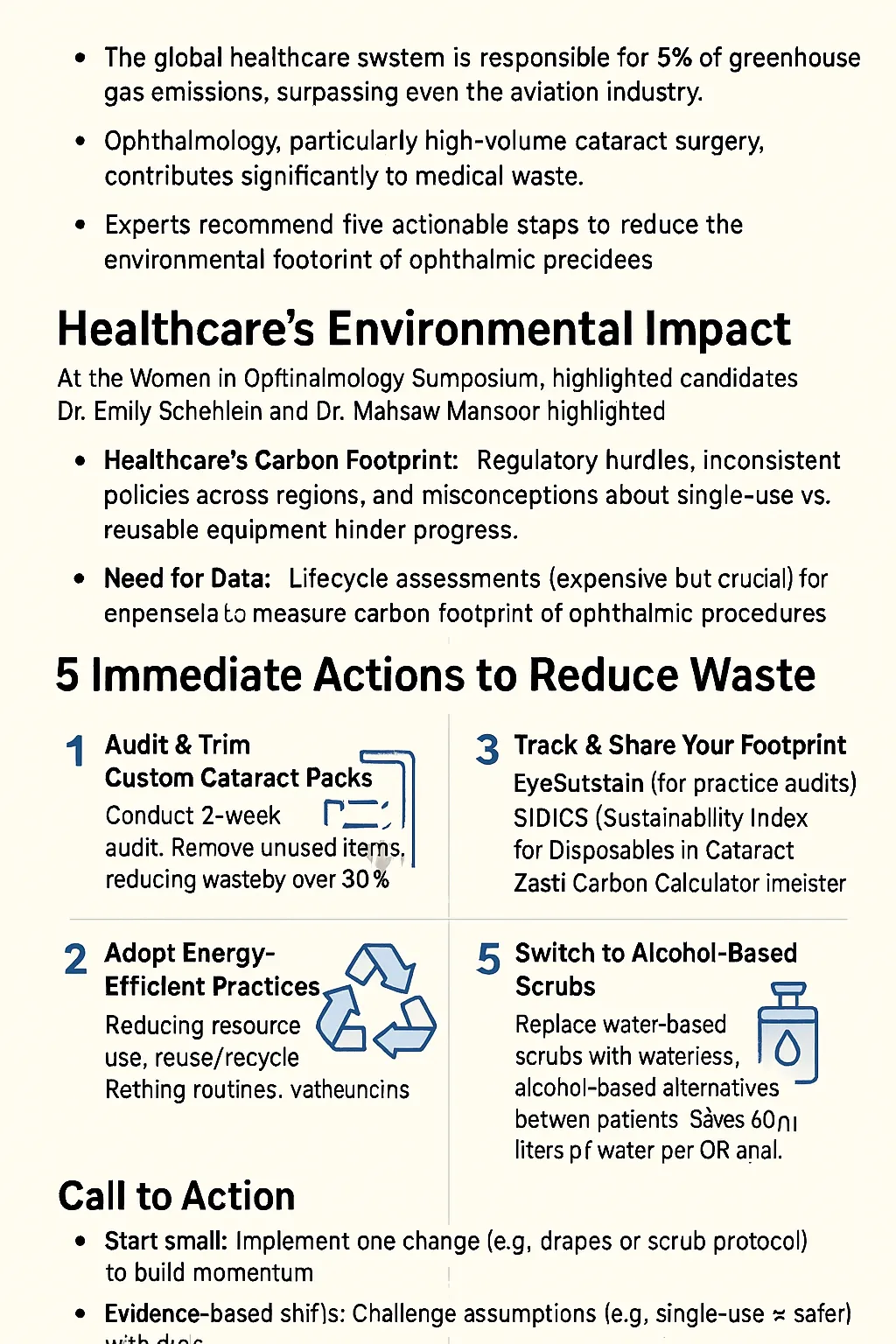Ophthalmologists Urged to Adopt Sustainable Practices
At the Women in Ophthalmology Summer Symposium held in Amelia Island, Florida, Dr. Emily Schehlein and Dr. Mahsaw Mansoor delivered a compelling presentation on the environmental responsibility of the healthcare sector, with a specific focus on ophthalmology. They argued that practitioners have a significant role to play in reducing the industry’s carbon footprint and provided five concrete, actionable steps to improve sustainability in their daily practice.
The Scale of the Problem
Dr. Emily Schehlein, a surgeon from Brighton Vision Center in Michigan, began by contextualizing the environmental impact of health care. She presented a striking statistic: the global health care system is responsible for 5% of all greenhouse gas emissions, a contribution larger than that of the entire aviation industry.
She emphasized that ophthalmology, in particular, has a heightened responsibility. As cataract surgery is the most frequently performed surgical procedure in the world, ophthalmologists are “high-volume proceduralists” whose collective practices generate a substantial amount of waste and carbon emissions.
Dr. Schehlein also identified the primary obstacles to improving sustainability:
- Regulatory Hurdles: Strict regulations, which are often inconsistent across different states and countries, can make it difficult to implement changes.
- Inertia and Safety Perceptions: There is a general resistance to changing established methods, often driven by the perception that single-use items are inherently safer. However, Dr. Schehlein noted that data does not always support this belief.
- Lack of Data: There is a need for more specialty-specific data to understand the carbon footprint of ophthalmology accurately. While “lifecycle assessments” are the proper tool for gathering this data on procedures, they are prohibitively expensive to conduct.

Five Recommendations for a Greener Practice
Dr. Mahsaw Mansoor of Advanced Vision Care in Los Angeles then outlined “five things you can do on Monday to make a difference,” providing a practical to-do list for ophthalmologists.
1. Trim Custom Surgical Packs:
Dr. Mansoor advised surgeons to perform a two-week audit of their custom cataract surgery packs to identify items that are consistently included but never used. She stated that this simple inventory check can reduce the emissions associated with a surgical pack by over 30% while also cutting costs.
2. Replace Full-Body Drapes:
She described the use of large, full-body drapes as “ridiculous” and unnecessary for ophthalmic procedures. Switching to smaller drapes is a safer, more cost-effective, and greener alternative that also improves patient comfort.
3. Track and Share Your Environmental Footprint:
Dr. Mansoor encouraged practices to audit their environmental impact using readily available tools. She recommended resources like EyeSustain, the Sustainability Index for Disposables in Cataract Surgery (SIDICS) found on ESCRS.org, and the Zasti Carbon Calculator. These tools make it easy to measure and understand a practice’s day-to-day carbon footprint.
4. Implement Basic Energy-Efficient Practices:
Revisiting the elementary school basics of “reduce, reuse, recycle,” Dr. Mansoor challenged attendees to add a fourth “R”: rethink. She suggested several practical applications:
- Reduce: Turn off slit lamps, microscopes, and other equipment when not in use. Be mindful of water consumption and question established norms, such as keeping the operating room at a very cold 60 degrees.
- Reuse/Recycle: Implement systems for recycling towels and batteries and consider using energy recovery systems.
5. Switch to Alcohol-Based Surgical Scrubs:
Dr. Mansoor advocated for a significant shift from traditional water-based scrubs to waterless, alcohol-based scrubs for use between patients (after an initial morning water-based scrub). She cited evidence confirming this method is both safe and effective. This single change offers substantial benefits, saving time and money, and has the potential for one operating room to conserve 60,000 liters of water annually.
She concluded by encouraging attendees to simply “just pick one” of these recommendations to start, emphasizing that even small initial steps can lead to significant positive change.
The presentation, titled “The environmental footprint of ophthalmology: Challenges and opportunities,” was noted to have no relevant financial disclosures from either speaker.

